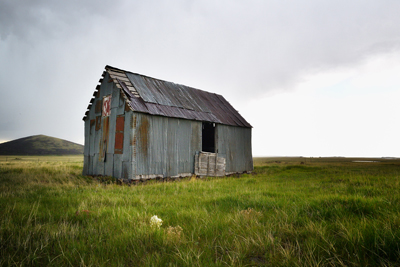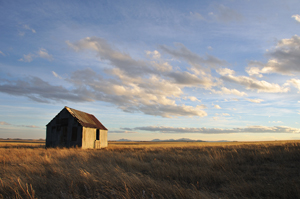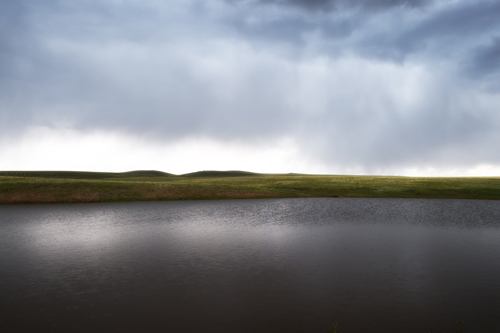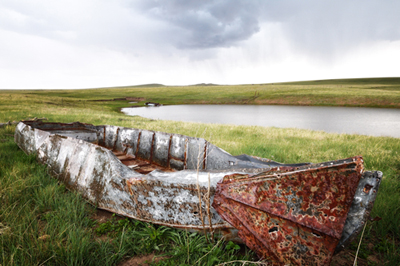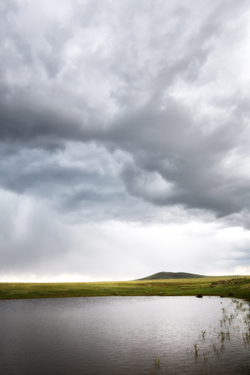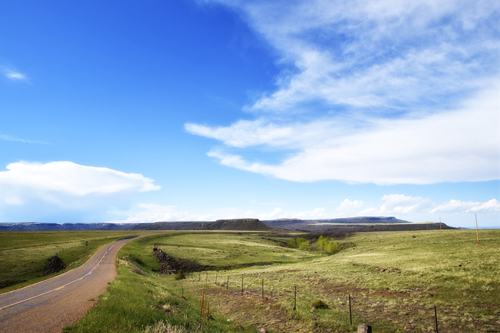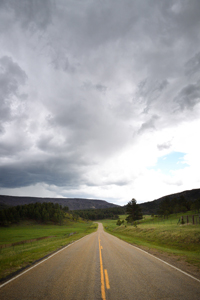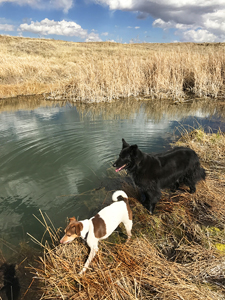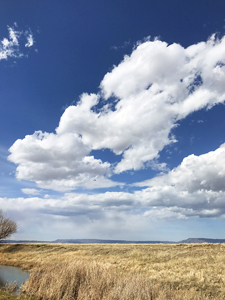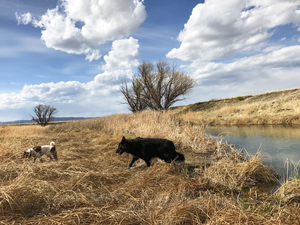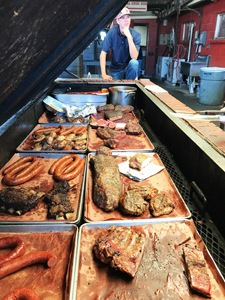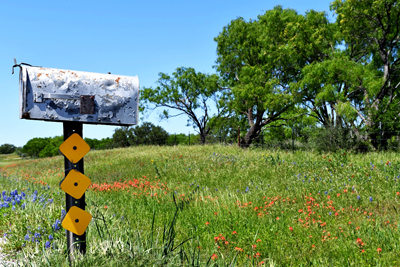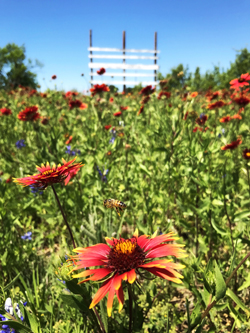|
June 6, 2017 Distance Although I've been a photographer more or less since I was a young boy, I didn't buy my own camera until ten years ago, waiting three months for the release of the Nikon D300 with the 18-200mm DX lens and receiving them the day after Thanksgiving, 2007. Ten days later, on December 7, I drove the long way home to Des Moines from teaching at Raton High School, driving across Johnson Mesa as the sun dropped to the western horizon behind me. Thrilled with my new camera, I took all the photos that I could find. One, which I titled "Distance," became my first big success. I had yet to figure out digital photo processing software so the image was a JPEG file straight out of the camera. (By that Christmas I'd switched entirely to RAW shooting.) The photo, at left, has since been licensed and published in a dozen or more magazines and books, even the cover of the regional phone book (young people can Google "phone book" to see what that was), one of fewer than ten of my images, in ten years, that has been published that many times. "Distance" hangs in the lobby of Cabezon Recreation Center in Rio Rancho (purchased by New Mexico Arts) and it's won awards in regional art and photography shows. All that from a JPEG straight from my first new camera when I still didn't know how to process a digital photo. I'm still a little amazed. So when we took an afternoon road trip over Johnson Mesa last week, I was happy to revisit the same shot. The stormy mid-afternoon light rendered that precise point of view ineffective, but the one at top worked nicely, again portraying the stillness of the magical mesa that is Johnson.
June 2, 2017 Boating We stayed just ahead of a fast-moving thunderstorm until we stopped at our neighbor Scott Berry's land atop Johnson Mesa, where his family homesteaded more than 100 years ago. There was plenty to walk, enjoy, and photograph there, so that's where the rain caught us. It didn't hurt the photography any. The stock pond is full from the spring's abundant rains. I aimed to capture a sense of the thunderstorm against the dark water and verdant land in the top photo, squatting at water's edge as the rain began to soak my parka. I was fascinated by this rusted old metal fishing boat--fishing on Johnson Mesa? I often find beautiful broad landscape images atop the mesa, but Monday we enjoyed getting out of the car and poking around for details that are more elusive. (I'm posting a couple additional Berry Ranch photos here at my arts blog, including Scott's horses and a rain-soaked Christina.) These photos were taken within a few minutes around the same stock pond. Getting a good photo doesn't necessarily mean that you're done. Where there's one good image, there are often others available. Keep seeing. ("Chimping" is a great verb that refers to a photographer spending time looking at new images in the camera display when he should be looking for more images.) I walked this land with Scott for my 2014 Chronicle-News profile when he became Raton's city manager. (Great story--recommended!) Scott's great grandfather homesteaded the land around 1900, moving up there from Raton after his brother was killed in an explosion at the Dutchman mine near today's Raton Country Club. An Irish immigrant, Patrick planted potatoes. That didn't take; it wasn't long before he was raising cattle instead. Eventually the family home had to be moved down off the high-elevation mesa to avoid the worst of the severe winters. In spring, summer, and fall, Johnson Mesa remains a gorgeous otherworldly land and, potentially, a photographer's paradise.
May 30, 2017 Johnson Mesa Christina suggested a great Memorial Day afternoon date for two--a road trip with cameras, up and over Johnson Mesa to Folsom from home in Raton, then back by the same route in different light. As afternoon thunderstorms loomed in the forecasts, the prospect grew for rain parkas and more dramatic photography. We left home as thunderclouds approached Raton from the west, headed east toward Texas and Oklahoma by way of 8000-foot-elevation Johnson Mesa. Our house sits at the base of Bartlett Mesa on the northeast outskirts of Raton. Heading east we reached Barela Mesa at Sugarite Canyon, then wound through Yankee Canyon (left) before climbing steeply upward to the top of Johnson Mesa. The photo above shows the mesa's northwest corner, where we first reached the top just 12 miles from home. Barela Mesa is in the far distance, with the Colorado state line below. A hundred years ago there were dozens of homesteads atop the mesa but nowadays there are only a few summer homes for cattle ranchers. The road is closed in winter due to deep snow. We visited our neighbor Scott Berry's land, where his family homesteaded about 120 years ago, and got lots of great photos even as, or because, the thunderstorms caught up with us. I'll post some of those here in the coming days, along with other photos and stories from the road trip here at my arts blog. April 17, 2017 Hiking the Hi Lo Country After all the greens in my Texas road trip photos below, you can tell here that I'm back home in northeastern New Mexico's Hi Lo Country! When I first moved to New Mexico in 1984, it took me awhile to adjust to all the browns, and the relative lack of greens. I'm still here so the transition took. I love our striking broad landscapes. At a water stop yesterday on one of my primary hiking routes, a six-mile ranch loop near Eagle Tail mountain southeast of Raton, I quickly pulled the iPhone 7 from my pocket, first to try to capture an alighting great blue heron, and then to catch my two pups as they ran across my frame at the pond. The heron is in the top right photo but, with the iPhone's wide angle and long depth of field, it's just a spot in the clouds. I can barely make it out when I click and enlarge the photo. The phone camera has been doing great on my travels and hikes, but here's a case where it couldn't compare to what the Nikon can do with its lenses. On the other hand, the Nikon rig is way too heavy and bulky to want to carry on a daily six-mile hike. We've had Django, our border collie, almost seven years and Jett, our Jack Russell terrier, more than two years. Django was rescued from the animal shelter at Las Vegas, New Mexico, and Jett from JRT Rescue of Fort Collins, Colorado, though he was originally from Colorado Springs where he was found near death after an animal attack. Django and Jett have both become avid daily hikers. Shortly after noon each day, throughout the four seasons, they watch carefully for my boots to emerge from the closet, then they go kinda crazy, all the way until the truck door opens to let them run. We generally hike between 90 minutes and two hours depending on the route. For all three of us, it's a daily gift to our physical and mental health. And each day I get to choose between green and brown, alternating hikes on high-mountain trails in Sugarite Canyon or Climax Canyon with hikes like yesterday's across sprawling pastures in the heart of the Hi Lo Country.
April 15, 2017 The Texas Hill Country For last week's road trip from New Mexico to San Marcos, Texas, we took one meandering route of Texas two-lanes on the way down and another a few miles further east on the way back. The return trip took us through Llano, in the heart of the Texas Hill Country, and I looked forward to it because I remembered Cooper's Old-Time Pit Bar-B-Que, probably the best barbeque joint I've known, then or now. We arrived hungry--as one must--and the line snaked outside where you point at your meat (above), then they slap it on a tray and you take it inside to weigh it. It's an unforgettable Texas experience. On the downtown courthouse square, just a block from the Llano River bridge, the Llano County Courthouse is built of big blocks of sandstone. Despite the mid-day light, big trees and deep shadows made the site photogenic. I used both the Nikon D5 and the iPhone 7 camera, then chose the best shot when I got home. Yet again, the phone camera won out!
April 11, 2017 Spring Wildflowers We timed last week's road trip to the Texas Hill Country to coincide with its annual profusion of bluebonnets and Indian paintbrush, avoiding the interstate highways in favor of the countless winding two-lanes. Like California, Texas has had lots of rain in recent months so we enjoyed many low-water bridge crossings. The mailbox photo above was taken with the Nikon D5 (with 85mm f/2.8 lens) but most of the photos I'll be posting were taken with the iPhone 7, which often does all I need when I'm not on a professional shoot. I shot this Indian paintbrush with both cameras and it turned out to be the iPhone that captured the bee taking off in response to my presence. Click to enlarge the shot and the bee--but the fact that you have to do that illustrates this image's shortcoming: the focal point is camouflaged and doesn't stand out, remaining barely visible. A photograph's focal point should stand out. In photographing wildflowers, the biggest challenge is finding or composing a focal point at all: A field of flowers doesn't have a focal point unless you find one, using composition and line or another interesting element. Here I used the bee and the abandoned billboard in the background, but it's not enough to create a great shot. If I was on assignment, I'd have taken the time, especially in morning and evening light, to find what I needed. Instead, we passed through at midday and took what we could find as we traveled--less ambitious but plenty of fun.
|
